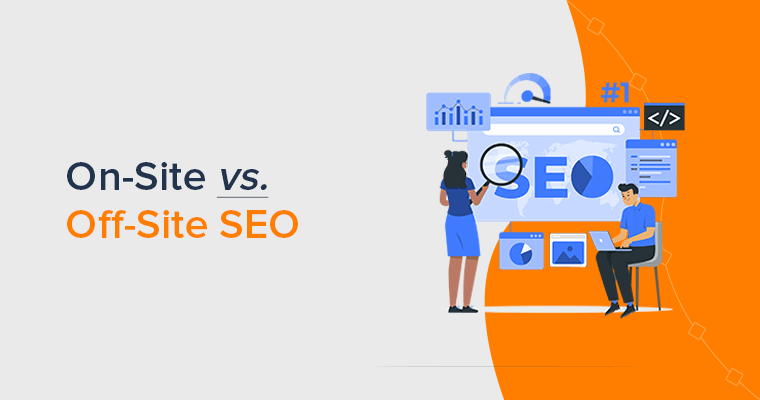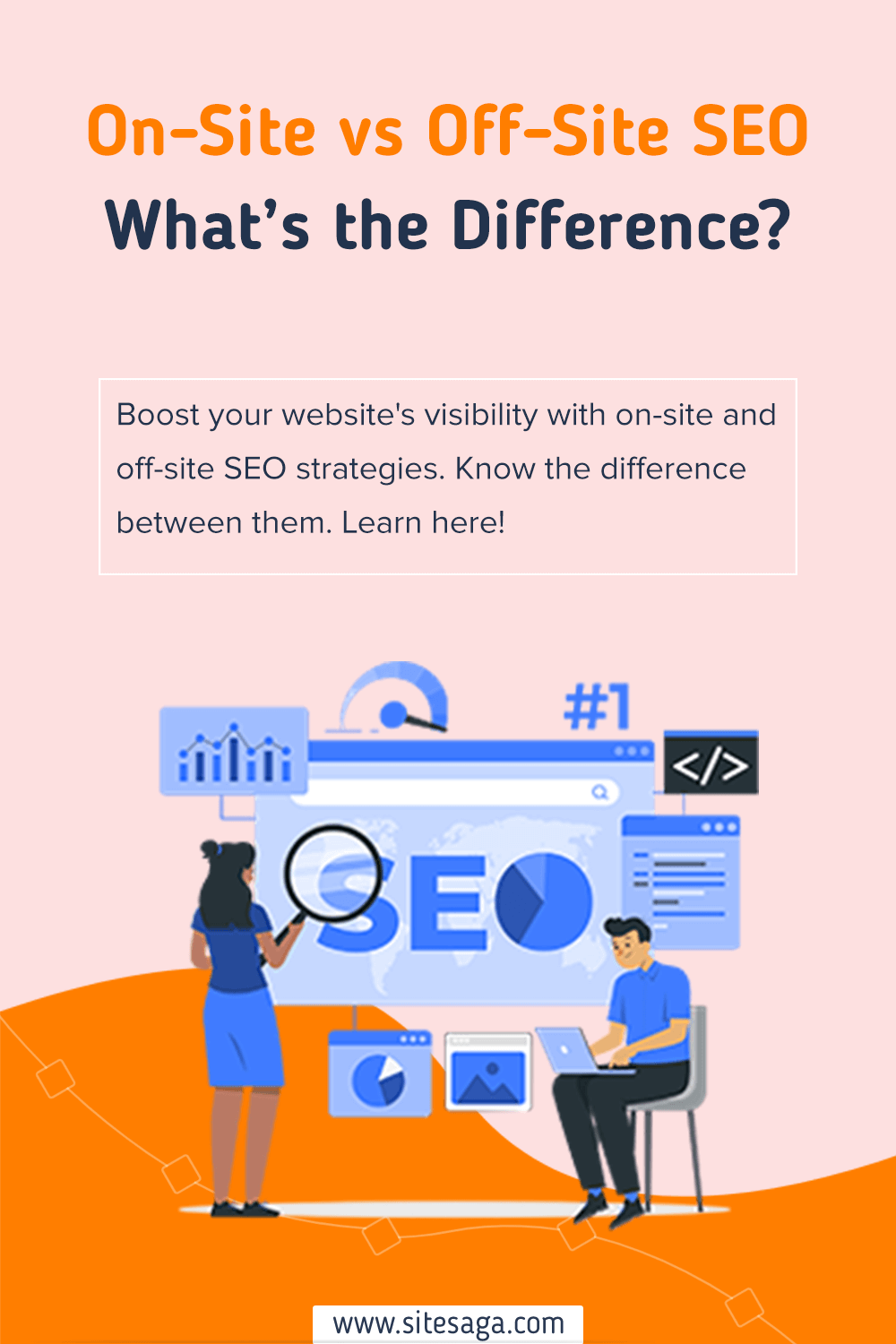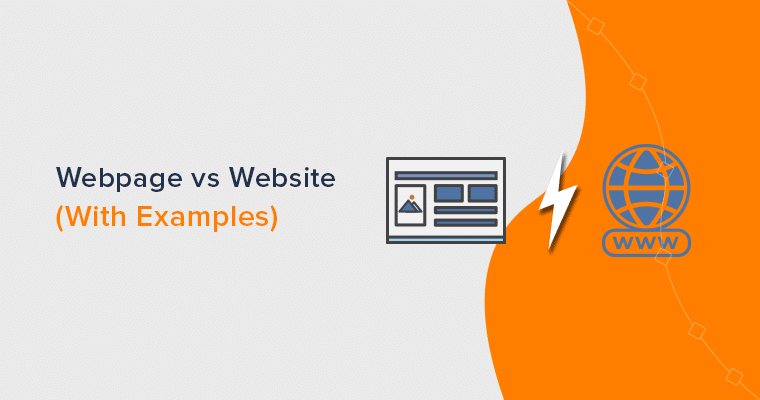Do you want to know the difference between on-site vs off-site SEO? Or are you wondering which approach is best for optimizing your website? If yes, then here we go!
Search Engine Optimization, or SEO, is a term that appears frequently in articles on creating successful websites. Depending on SEO, determines how difficult it is for the search engines to identify and index your site.
The idea of using keywords is simple enough to understand, but other SEO ideas are more complicated.
For instance, what distinguishes onsite from offshore SEO is a question we receive frequently. Hence, we’ve decided it’s about time we made an effort to clarify how more people may find the solution.
Thus, if you’re confused about which of these options would be better for your website, then don’t worry. In this article, we’ll compare on-site SEO with off-site SEO in different aspects of optimizing the website. So, let’s dig in!
What is SEO? – A Brief Introduction
Before we begin the comparison between on-site vs off-site SEO, let’s have a brief overview of SEO.
Search Engine Optimization (SEO) is the process of improving a website’s visibility and ranking on search engine results pages (SERPs). It implies strategic changes to various elements of a website, such as its content, structure, and backlink profile. This helps to increase its relevance and authority in the eyes of search engines like Google.
SEO’s main goal is to attract more organic traffic to a website by appearing higher in the SERPs for relevant keywords and queries.

When it comes to SEO, it encompasses both on-site and off-site optimization techniques. On-site optimization involves optimizing the website’s content, meta tags, headings, and URLs to make them more search engine-friendly.
Meanwhile, off-site optimization involves building high-quality backlinks and social media promotion for the website’s authority and trustworthiness to search engines.
Hence, implementing effective SEO strategies increases your business website’s online visibility. Indeed, it helps to attract more targeted traffic and ultimately drives more conversions and business growth.
What is an On-Site SEO? – Overview
On-site SEO is the process of optimizing various elements within a website to improve its visibility and ranking on the SERP. It makes strategic changes directly on the website, enhancing its relevance, user experience, and search engine friendliness.
The main goal of it is to make sure that search engines can easily crawl and understand the website’s content. Along with that, this should provide a positive user experience.
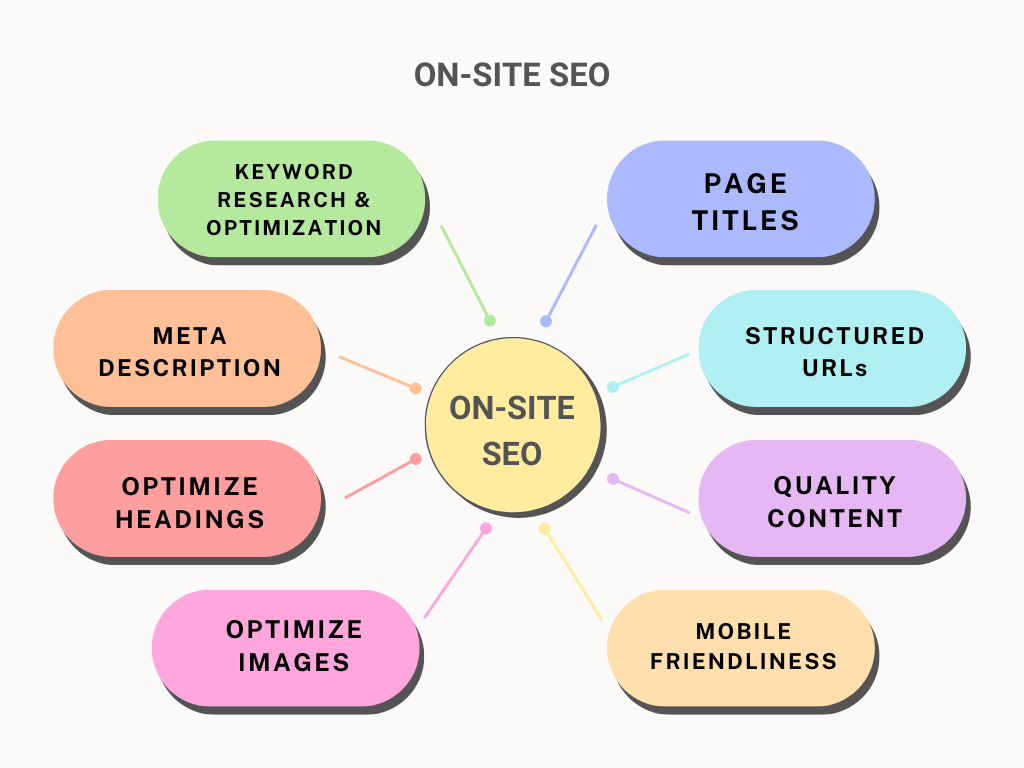
For that, it conducts keyword research and adds relevant keywords naturally into the content. Also, you can optimize meta tags and headings, create descriptive and user-friendly URLs, and logically organize the website’s structure.
Undoubtedly, a well-organized website can make it easier for search engines to crawl and understand the content. Besides that, it includes logical internal linking, quality content, and optimized images, to make it more search engine-friendly and user-friendly.
Hence, implementing effective on-site SEO techniques can increase the chances of your website ranking higher in the SERP for relevant queries. As a result, it automatically increases organic traffic, improves visibility, and creates more opportunities for conversions and business growth.
Thus, on-site SEO is an essential foundation for any successful search engine optimization strategy.
What are On-Site SEO Ranking Factors?
On-site SEO ranking factors are those elements that help you optimize directly on your website to improve its visibility and rankings in SERPs. Thus, here are some key on-site SEO ranking factors:
1. Keyword Research and Optimization
Keyword research and optimization are crucial aspects of any SEO. It involves identifying relevant keywords and using them strategically in your website’s content.
Moreover, keyword research is the process of identifying and analyzing the specific targeted words that people use when searching for information on search engines. Its goal is to understand the keywords that your target audience uses to find content related to your website.
Similarly, keyword optimization is the process of strategically including targeted keywords in your website’s content. So, it can help improve the visibility of your website in search engine rankings.
Here are some of the effective keyword research and optimization to involve in your next SEO.
- Identify the target keywords and topics that are relevant to your website or business. Need to brainstorm potential keywords and phrases.
- Use keyword research tools such as SEMrush and Moz Keyword Explorer to discover keyword ideas, search volumes, and related terms.
- Choose keywords that accurately represent what your content offers and what users are looking for.
- When writing compelling meta descriptions include keywords with a concise summary of your content.
- Optimize your URL and alt tags for images by including relevant keywords that describe the page’s content.
- You should avoid keyword stuffing – overusing keywords in a way that sounds unnatural or manipulative.
Hence, you need to remember that keyword research and optimization should always prioritize the user experience with valuable content.
Are you planning to use SEMrush as your keyword research tool? If so then check out our in-depth article on how to use SEMrush for free.
2. Page Titles
Page titles are one of the most crucial on-site SEO elements. It plays a significant role in conveying the relevance and topic of a webpage to search engines and users.
Search engines consider the page title when determining the relevance of a webpage to a user’s search query.
A well-optimized page title contains relevant keywords. It helps search engines understand the content and context of the page. Hence, it increases the chances of ranking higher in search results for relevant queries.
Even more, a compelling and well-optimized page title appears as clickable links in SERPs. It attracts users’ attention, leading to higher click-through rates.
Moreover, it contributes to a better user experience by providing clear and concise information about the content of the webpage. Also helps users navigate search results more efficiently and find the information they seek.
Thus, consistent and well-optimized page titles build your brand’s identity and messaging. It even makes it easier for users to recognize and associate your content with your brand.
To learn more about what a website title is and why it is important for SEO, click here.
3. Meta Description
When it comes to optimizing meta descriptions, it’s another important element of on-site SEO. It provides a precise summary of a webpage’s content and significantly influences user behavior and search engine rankings.
We all know that meta descriptions appear in SERPs as a preview of the webpage’s content. A well-optimized and compelling meta description can lure users to click on the link and visit the webpage.
It can accurately represent the content and appeal to users’ search intent. Hence, it can increase the likelihood of attracting clicks and improve your CTR.
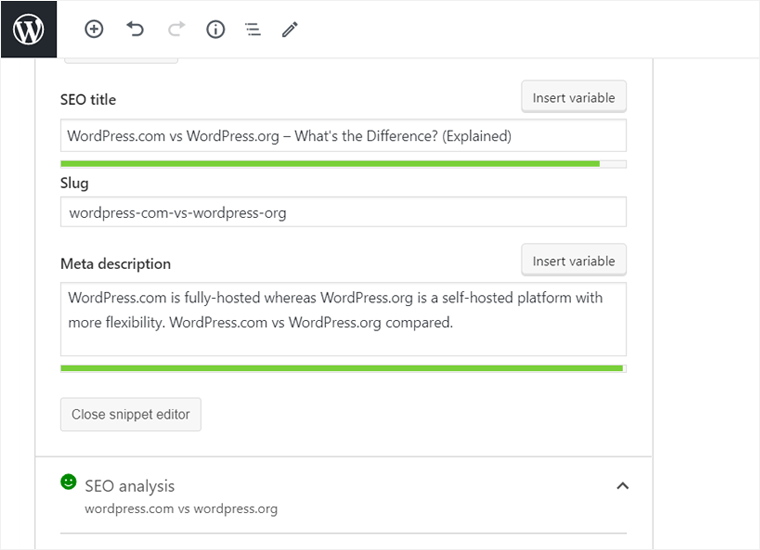
Although meta descriptions don’t directly impact search engine rankings, they can indirectly influence rankings through user engagement metrics. As mentioned, engaging and relevant meta descriptions for users’ search queries are more likely to increase clicks on the link.
Furthermore, a carefully crafted meta description can highlight key selling points, unique offerings, or compelling benefits. Thus, it attracts the attention of users who’re searching for specific information or solutions.
More so, when your content is shared on social media platforms, the shared link includes a meta description. That’s why optimizing meta descriptions with concise information increases the likelihood of users clicking on the shared link.
Additionally, a well-crafted meta description builds strong brand awareness and recognition for your content.
In fact, when optimizing meta descriptions, always keep them within the recommended character limits, typically around 150-160 characters. This ensures that meta descriptions are fully displayed in search results.
4. Structured URLs
A structured URL is a web address that is well-organized and descriptive of the content or purpose of the webpage. It must follow a hierarchical structure and provide meaningful information to both users and search engines.
A structured URL must include relevant keywords that accurately describe the content of the webpage. Not just that, it should be user-friendly, easy to understand, and memorable.
Most of the structured URLs contain directories or categories that reflect the organization of the website. This makes it easier for users and search engines to navigate and comprehend the site’s structure.
Here’s an example of a structured URL:
Unstructured URL –
www.example.com/product?id=12345
Structured URL –
www.example.com/products/clothing/mens/pants
In the example above, the structured URL indicates that it belongs to the “products” section of the website. Perhaps it specifically refers to the “clothing” category, and more specifically the “mens” subcategory. Inside that, it specifically mentions the product name, i.e. “pants”.
Hence, looking at that example, we can say that it’s descriptive and meaningful.
Hence, using structured URLs makes it easier for users and search engines to understand and navigate your site. Moreover, it works to improve the user experience, boost search engine visibility, and increase click-through rates.
As a result, it provides users with a clear indication of what they can expect when they click on the link.
5. Optimize Headings
Optimizing headings in SEO means strategically using HTML heading tags to structure and organize the content on web pages.
Headings provide a hierarchical structure to your content. This allows your users and search engines to easily understand the flow of information on the webpage.
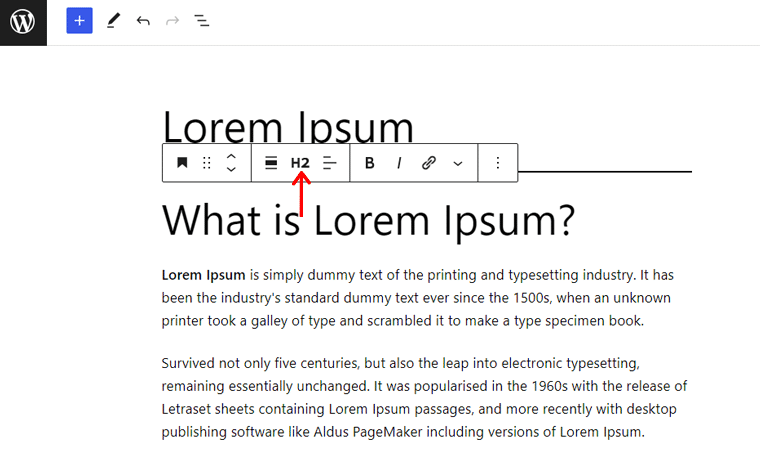
Meanwhile, when you include relevant keywords in headings, it reflects the main topics of the webpage. Naturally incorporating keywords into headings provides search engines with additional signals about the content’s relevance to specific search queries.
When headings are properly structured, it enhances the accessibility of your content for users with screen readers or other assistive technologies.
Likewise, search engines make use of the semantic meaning of headings to better understand the context. It helps search engines interpret the content and its hierarchy accurately.
Lastly, optimized headings increase the chances of your content appearing in featured snippets. Whereas, sometimes search engines also use it to generate featured snippets.
Hence, well-structured and informative headings can improve your visibility and drive more traffic to your website.
Here are a few best practices to consider while optimizing headings for SEO –
- Always use a single H1 tag per webpage.
- Make use of heading tags (H2, H3, etc.) to structure subheadings. As it helps to create a logical hierarchy within your content.
- Include relevant keywords naturally into your headings and avoid keyword stuffing.
- Should keep your headings concise and descriptive, accurately summarizing the content that follows.
6. Quality Content
In on-site SEO, quality content means creating well-crafted and relevant content that is optimized for both search engines and users. It consists of various aspects, including the writing style, the structure, and the overall user experience.
Search engines’ only aim is to provide users with the most relevant and high-quality content for their search queries. Thus, quality content that aligns with user intent is more likely to rank higher in the SERPs.

Search engines rely on relevance, user engagement, and backlinks to assess the quality of content and determine its ranking position.
Even more, quality content guarantees to enhance the user experience on your website. Whenever the users find valuable and engaging content, they’re more likely to stay longer and browse throughout your website.
When you provide valuable and relevant content, you can lower your bounce rates. Hence, this keeps users engaged and exploring more of your website. Also, it positively impacts your search engine rankings and overall on-site SEO performance.
Lastly, quality content refers to valuable, relevant, and well-optimized content that meets user needs and expectations. Similarly, it improves search engine rankings, enhances the user experience, reduces bounce rates, and drives organic traffic.
Here are some key practices to follow to create quality content for your website:
- Understand Your Audience – Always conduct thorough research to understand your target audience’s demographics and interests.
- Work on Content Strategy – Outline a clear content strategy that aligns with your business goals. Based on your audience, determine the types of content you’ll create and the topics you’ll cover.
- Use Clear and Engaging Writing – Write your content in a clear, concise, and conversational style. Always break up your content into shorter paragraphs and use subheadings to improve readability.
- Easily Scannable and Readable – Try using bullet points, numbered lists, and subheadings to break up your content. Make use of formatting elements such as bold, italics, or blockquotes to highlight important information.
- Develop a Habit of Proofreading – You must thoroughly proofread your content to eliminate grammatical errors, typos, and inconsistencies.
These are a few best practices you need to follow to create quality content. This will help to engage your audience, establish your authority, and drive traffic to your website.
Keeping these concerns in mind, check out the ultimate checklist to make a good website.
7. Optimize Images
When talking about optimizing images, it means ensuring that the images on your website are optimized for search engines. It involves several practices aimed at improving the visibility, relevance, and performance of images.
Here are some key aspects of optimizing images for on-site SEO:
- Image Compression – Compressing the images reduces the file size without significantly compromising their quality. It helps you improve page load times, resulting in a faster and more responsive website.
- Image File Formats – The users should choose the appropriate file format for their images. For photographic images, use JPEG format and PNG format for transparent backgrounds or graphics.
- Descriptive File Names – Give your image files descriptive and relevant names that reflect the content of the image.
- Alternative Text (Alt Text) – Optimize alt text by providing descriptive and keyword-rich descriptions that accurately represent the content and context of the image.
- Image Captions – Use captions to provide additional context and information about the image. If possible, then include relevant keywords in the captions.
Hence, by optimizing images, you can improve website performance, enhance the user experience, and increase the visibility of your images in SERPs.
For more, you can check our article on best image optimization plugins for WordPress for optimizing your images
8. Mobile Friendliness
Mobile-friendliness is the process of optimizing a website to provide an excellent user experience on mobile devices.
In today’s time, with the increasing use of smartphones, it’s important to cater to mobile users too. Hence, websites should be designed and developed in such a way that they’re easily accessible and readable on smaller screens.
In comparison to desktop users, mobile users seem to have different browsing habits and expectations. Hence, a mobile-friendly website allows them to easily navigate, read content, and interact with the site on their mobile devices.

Thus, it encourages them to stay longer, engage with the content, and potentially convert into customers or subscribers.
Even more, it has become a significant ranking factor in search engine algorithms. Nowadays, search engines prioritize mobile-friendly websites in their mobile search results.
Lastly, a website that is not mobile-friendly may have high bounce rates. This results in difficulties in navigation and slow loading times. Ultimately, your visitors will leave the site as soon as they land on it.
That’s why make sure you’ve got a mobile-friendly website. It not only makes it easier for your visitors to access your content but also reduces bounce rates.
To make your website mobile-friendly, consider the following practices:
- Responsive Design – Use a responsive design that automatically adjusts the layout and content of your website based on the screen size.
- Readability – Use suitable fonts, appropriate font sizes, and ample spacing between elements. This makes it easier for users to read your content without zooming or scrolling excessively.
- Mobile-Friendly Navigation – Make your website’s navigation smoother for mobile users. Use intuitive icons, and clear calls-to-action to help users find what they’re looking for quickly.
- Page Load Speed – Always compress images, minify code, and leverage caching techniques to ensure fast page loading for mobile devices.
- Touch-Friendly Elements – Focus on your website’s buttons, links, and interactive elements. They must be large enough and spaced adequately to be easily clickable.
Hence, prioritizing mobile-friendliness in on-site SEO can provide an optimal user experience and improve your search engine rankings. Also, it lets you effectively engage with your mobile audience, ultimately driving more traffic and conversions to your website.
What is an Off-Site SEO? – Overview
Unlike on-site SEO, off-site SEO takes actions outside of your website to improve its search engine rankings and online reputation. This includes strategies that focus on building relationships, generating backlinks, and establishing your website’s authority and credibility across the web.
Meanwhile, other key components of off-site SEO include social media engagement, online directories, and listings, content marketing, and local SEO.
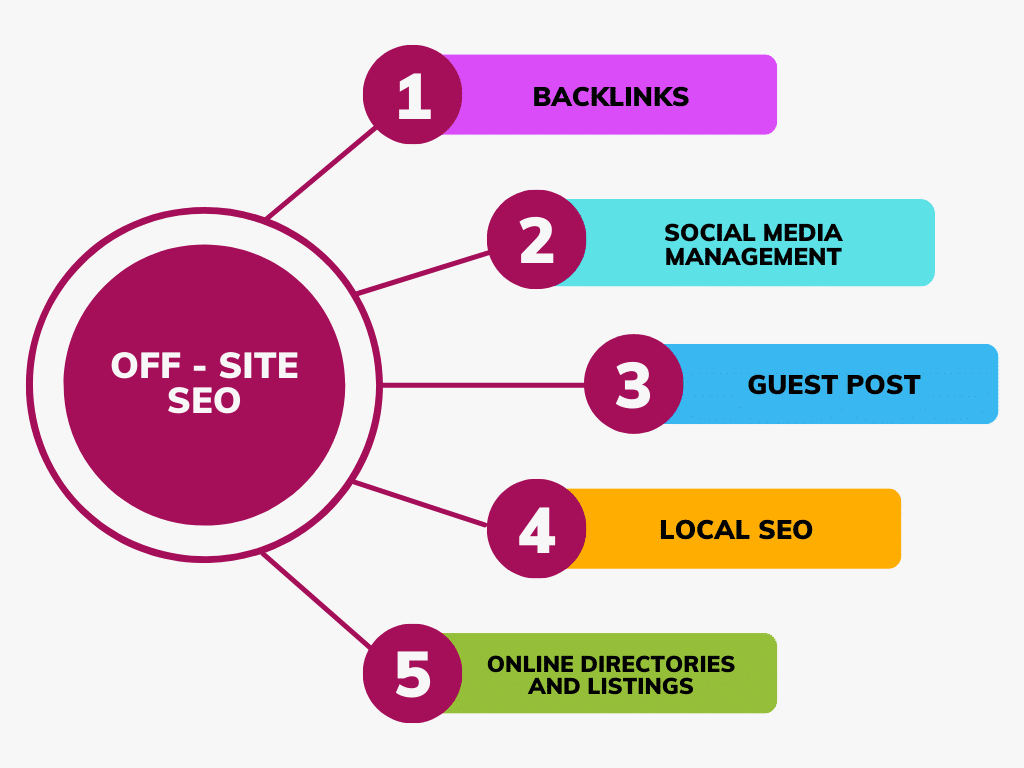
In fact, off-site SEO primarily focuses on generating high-quality backlinks from authoritative and relevant websites. It acts as a vote of confidence for search engines, indicating the value and relevance of your content.
When you generate quality backlinks from reputable sources, your website is more likely to rank higher in the SERPs.
Additionally, it engages your audience through social media, sharing your content across various platforms, and participating in online communities. Thus, such activities help increase your website’s visibility, attract more organic traffic, and enhance your online reputation.
Overall, when you implement effective off-site SEO techniques, you can enhance your website’s authority, reputation, and search engine rankings. As a result, it helps to drive more organic traffic and boost your online presence.
Hence, it’s a continuous process that requires consistent effort and monitoring to achieve long-term success.
What is Off-Site SEO Ranking Factors?
Off-site SEO ranking factors refer to elements outside of your website. These elements can influence its search engine rankings. Hence, it helps search engines determine your website’s authority, relevance, and credibility.
Here are some key off-site SEO ranking factors:
1. Link Building (Backlinks)
Link building (backlink) is one of the fundamental aspects of off-site SEO. It’s a well-used SEO strategy to acquire links from external websites that point to your website.
Here, you acquire hyperlinks from external websites to your own. It acts as a vote of confidence, which signals to search engines that your website is reputable and trustworthy.
Nonetheless, it helps to improve your website’s visibility and rankings in search engine results pages.
For instance, let’s say some reputable websites want to link to your content. As they link to your content, search engines perceive your site as more authoritative. This helps your website to lead to higher rankings.
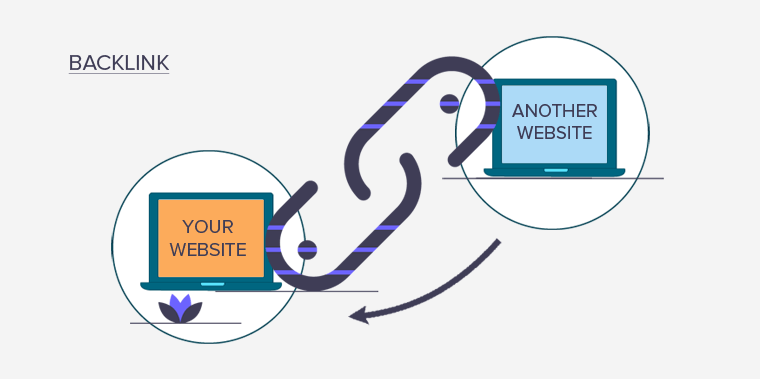
Hence, backlinks also drive organic referral traffic. Let’s say, users who encounter your links on other websites may click on them to visit your site.
At the same time, everyone should know that not all backlinks are created equal. QUALITY DOES MATTER!! Backlinks from authentic websites are preferred over those from other sites.
When it comes to effective link-building, it involves creating high-quality content that’ll naturally attract backlinks. Hence, it’ll reach out to relevant websites for guest blogging opportunities and build relationships with influencers in your industry.
In summary, link building helps acquire backlinks from reputable websites to improve the site’s authority, visibility, and rankings in SERPs. It is an essential off-site SEO strategy that focuses on quality, relevance, and natural link acquisition methods.
2. Social Media Management
Social media management in off-site SEO means managing your brand’s presence on social media platforms. This will help to enhance your website’s visibility, engagement, and overall online reputation.
In this, you’ll create and share compelling content, interact with users, and monitor social media mentions. So, you can leverage social signals to positively impact your search engine rankings.

Whenever you’re creating content, you must make sure that you develop relevant and engaging content tailored for social media platforms. You should include posts, images, videos, and other media formats that suit your target audience.
Further, you can build relationships with followers by actively engaging with them. For that, foster a conversation and respond to their comments and messages. In this way, you can generate brand loyalty and advocacy.
Similarly, social media activities – likes, shares, retweets, and comments, can act as social signals to search engines. Popular and engaging content can indirectly influence search rankings to drive more traffic and indicate content quality.
In a nutshell, if you effectively manage your brand’s presence on social media, you can boost your online reach. Hence, it enhances your website’s visibility and reputation in the eyes of search engines.
3. Guest Post
A guest post is a strategy for writing and publishing content on someone else’s website as a guest author. You can create valuable and relevant content for an external website that allows guest contributions.
This strategic approach helps to build backlinks, increase brand exposure, and expand your online presence.
Alongside that, it provides an opportunity to add links back to your own website within the content. These backlinks from reputable websites can improve your website’s authority and search engine rankings.
After that, it helps you reach out to new audiences and attract potential visitors to your own site. This way, you can increase brand awareness and drive relevant traffic.
Also, through guest posting, one can showcase their knowledge and expertise in a particular industry. Indeed, it opens doors for opportunities, like joint ventures, partnerships, or more guest posting opportunities.
Not just that, you can repurpose and share guest posts across various platforms, such as social media and newsletters. This magnifies the reach of your content and increases its potential impact.
While creating a guest post, it’s important to focus on building high-quality content that provides value to the readers. You should always remember that guest posting needs to be approached ethically with genuine intention.
4. Local SEO
Local SEO is the process of optimizing your online presence to improve visibility and attract customers from a specific geographic location. You implement strategies and tactics to make your business appear in local search results.
Especially for businesses that have physical stores or serve customers in specific regions. It allows you to easily connect with your target audience at the local level. Thus, it increases the likelihood of attracting customers who are geographically close and ready to make a purchase.
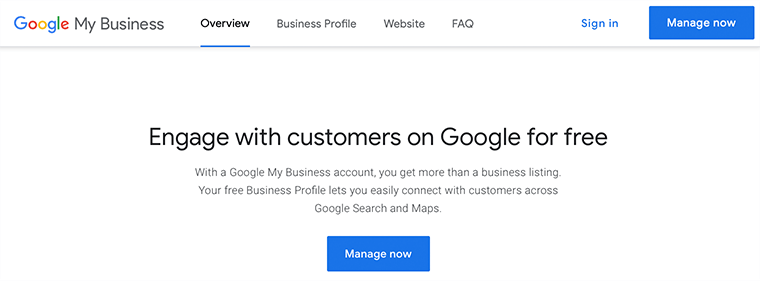
Within local SEO, you can claim and optimize your Google My Business profile. In this, you can provide your business information, add photos, manage reviews, and post updates. So that, search engines can link your business with specific locations and improve local search visibility.
In fact, you can encourage and manage customer reviews on online platforms like Google, and Yelp. Thus, any positive reviews of your business can boost your online reputation and attract more local customers.
For more, you can ensure your business information is up-to-date on online maps and GPS platforms like Google Maps. This will help your users find your physical location easily.
Thus, optimizing local SEO in off-site SEO is crucial for businesses that rely on local customers. It allows your business to appear in local search results, increasing visibility in your target area. Further, it drives relevant traffic to your website or physical store.
By effectively implementing local SEO strategies, you can enhance your online presence and attract local customers to grow your business.
5. Online Directories and Listings
Online directories and listings are platforms that compile business information and provide a directory-like listing of businesses. It serves as a valuable source of information for users looking for businesses or services in their area.
Evidently, it allows businesses to create profiles and provide essential information like business names, addresses, email addresses, and contact details. So that users can easily find the information and connect with businesses relevant to their needs.
Also, listing your business in relevant online directories can contribute to your local SEO efforts.
Nonetheless, consistently maintaining business information across multiple platforms helps search engines validate the legitimacy of your business.
Meanwhile, some online directories also include review features on their platform. This allows customers to leave feedback, ratings, and reviews about their experiences with a particular business. So, positive reviews can improve your online reputation and attract more customers.
Hence, listing your business in online directories helps expand your online presence. As a result, it increases your visibility to potential customers and strengthens your off-site SEO signals.
FAQs – On-Site vs Off-Site SEO
SEO (Search Engine Optimization) is the practice of improving a website’s visibility and ranking on SERPs through various techniques and strategies. Its main aim is to attract more organic (non-paid) traffic to your website.
On-site SEO is the optimization strategy directly implied on a website to improve its search engine visibility. It involves optimizing elements such as meta tags, headings, keywords, content quality, site structure, and internal linking.
Off-site SEO is the optimization technique performed outside of a website to improve its search engine rankings and visibility. It focuses on building high-quality backlinks, social media engagement, online reputation management, and other external factors.
Off-site SEO allows you to build authoritative backlinks, increasing organic traffic. Additionally, it allows businesses to expand their online presence and foster brand awareness through social media mentions and online partnerships.
Both on-site and off-site SEO is important for comprehensive and effective website optimization. On-site SEO makes sure that your website is optimized for search engines with stronger search visibility. While off-site SEO helps to build authority, credibility, and reputation for your website through external signals and backlinks.
Conclusion
That’s all, folks! We’ve come to the end of this comparison article between on-site vs off-site SEO.
Finally, we would like to say that both of these options are the best in their respective fields. We hope this article helped you understand the differences between on-site and off-site SEO.
If you have any further questions about on-site and off-site SEO, then please leave a comment below. We’ll try to get back to you as soon as possible.
Also, let us know which one you are going to use for your next project. You can share your pick in the comments section below. Indeed, make sure to share this article with your friends and family too.
You might like our other articles, like the best SEO tools for small businesses and the best web hosting for SEO. Make sure to go through it once.
Lastly, remember to like and follow us on our social media handles, Facebook and Twitter, to keep a close eye on our articles.
